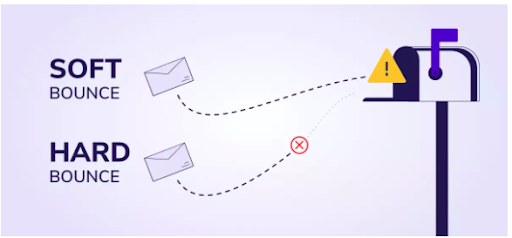Hard Bounce
Definition
A hard bounce is an email message returned to the sender because it is permanently undeliverable to the recipient.
Description
A hard bounce is an email message returned to the sender because it is permanently undeliverable to the recipient.
This happens when an email is sent to an invalid or non-existent email address or when the recipient’s email server is blocking the email for various reasons, such as an invalid email account, inactive email account, or a full mailbox.

Hard bounces can negatively affect email deliverability and sender reputation, so it’s essential to regularly clean email lists and remove any invalid or inactive email addresses.
Therefore, it is essential for email marketers to regularly clean their email lists and remove any invalid or inactive email addresses to prevent hard bounces and maintain good email deliverability.
Why is it important to find out about Hard Bounce?
Finding hard bounces is essential because:
- They can negatively impact email deliverability and sender reputation.
- When an email message bounces, it indicates to the email server that the recipient address is invalid or non-existent, which can result in the sender being flagged as a spammer.
- This can lead to future emails from the sender being blocked or sent to the recipient’s spam folder, which can significantly reduce the effectiveness of email marketing campaigns.
- Email marketers can improve their deliverability rates and maintain a good sender reputation by identifying hard bounces and removing them from email lists.
How to prevent hard bounce?
Here are some ways to prevent hard bounces:
- Use double opt-in: Double opt-in is a process that requires new subscribers to confirm their email addresses before being added to the mailing list. This helps to ensure that the email address is valid and active, reducing the likelihood of hard bounces.
- Regularly clean email lists: Regularly clean email lists to remove any invalid or inactive email addresses. This can be done by periodically monitoring bounce rates and removing any addresses that have hard bounced.
- Verify email addresses: Verify email addresses before sending emails to ensure they are valid and active. This can be done using email verification services or by sending a confirmation email to new subscribers.
- Use a reputable email service provider: Use a reputable email service provider that has strong email deliverability rates and regularly monitors email lists for bounces and other issues.
- Avoid using purchased email lists: Purchased ones can contain outdated or invalid email addresses, increasing the likelihood of hard bounces. Instead, build your email list through organic methods such as opt-ins and sign-ups.
Benefits to find out hard bounce
There are several benefits to finding out hard bounces:
- Improved deliverability: By identifying and removing hard bounces from email lists, email marketers can improve their deliverability rates and ensure that future emails are more likely to be delivered to the intended recipients.
- Better sender reputation: Hard bounces can negatively impact sender reputation, as they indicate poor list hygiene and can lead to increased bounce rates. By proactively managing email lists and removing hard bounces, email marketers can maintain a good sender reputation.
- Increased engagement: Removing hard bounces from email lists can also help to increase engagement rates, as it ensures that emails are only sent to active and engaged subscribers who are more likely to open, click, and respond to emails.
- Cost savings: Email marketing can be costly, and sending emails to invalid or non-existent email addresses can result in wasted resources and increased costs. By removing hard bounces, email marketers can reduce costs and improve the ROI of their email marketing campaigns.
Example
Delivery to the following recipient failed permanently:
rohan.sharma@abc.in
Technical details of permanent failure: The email account you tried to reach is no longer used. Please check the recipient’s email address and try again.
This is an example of a complex bounce message that indicates that the email was not delivered because the recipient’s email account is no longer in use.
This hard bounce can occur when the recipient has closed their email account or their email service provider has terminated it.
Identifying and removing such email addresses from the mailing list is essential to prevent future hard bounces and maintain reasonable email deliverability rates.
FAQ
What is a hard bounce?
A hard bounce is a permanent failure to deliver an email message to a recipient’s email address. For example, this bounce occurs when the recipient’s email address is invalid, non-existent, or blocked.
What causes a hard bounce?
Hard bounces can be caused by various factors, including invalid or non-existent email addresses, inactive email accounts, email addresses that have been closed or terminated, or email addresses that have been blocked or marked as spam.
Why is it essential to monitor hard bounces?
Monitoring hard bounces is vital for maintaining reasonable email deliverability rates and avoiding potential negative impacts on the sender’s reputation.
By identifying and removing hard bounces from email lists, email marketers can improve their deliverability rates and ensure that future emails are more likely to be delivered to the intended recipients.
How can I prevent hard bounces?
To prevent hard bounces, it is essential to regularly clean email lists, verify email addresses, use a reputable email service provider, avoid using purchased email lists, and use double opt-in processes to confirm the validity of email addresses before adding them to the mailing list.
What should I do if I receive a hard bounce message?
If you receive a hard bounce message, removing the email address from your mailing list and updating your email list hygiene practices to prevent future hard bounces is essential. Contact the recipient to confirm their email address or obtain a new one.





We would love to have your opinion.